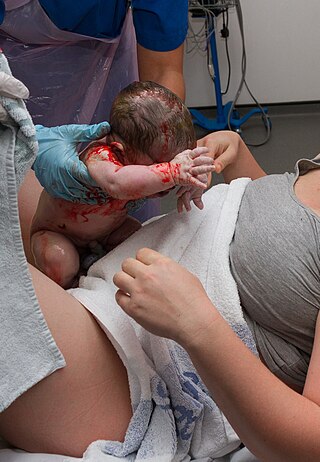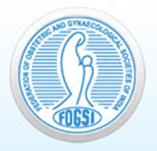Dilationand curettage (D&C) refers to the dilation (widening/opening) of the cervix and surgical removal of part of the lining of the uterus and/or contents of the uterus by scraping and scooping (curettage). It is a gynecologic procedure used for diagnostic and therapeutic purposes, and is the most commonly used method for first-trimester miscarriage or abortion.

Obstetrics and gynaecology is the medical specialty that encompasses the two subspecialties of obstetrics and gynecology.
Late termination of pregnancy, also referred to as third trimester abortion, describes the termination of pregnancy by induced abortion during a late stage of gestation. In this context, late is not precisely defined, and different medical publications use varying gestational age thresholds. As of 2015 in the United States, more than 90% of abortions occur before the 13th week, 1.3% of abortions in the United States took place after the 21st week, and less than 1% occur after 24 weeks.

Misoprostol is a synthetic prostaglandin medication used to prevent and treat stomach and duodenal ulcers, induce labor, cause an abortion, and treat postpartum bleeding due to poor contraction of the uterus. It is taken by mouth when used to prevent gastric ulcers in people taking nonsteroidal anti-inflammatory drugs (NSAID). For abortions it is used by itself or in conjunction with mifepristone or methotrexate. By itself, effectiveness for abortion is between 66% and 90%. For labor induction or abortion, it is taken by mouth, dissolved in the mouth, or placed in the vagina. For postpartum bleeding it may also be used rectally.

The International Federation of Gynaecology and Obstetrics, usually just FIGO ("fee'go") as the acronym of its French name Fédération Internationale de Gynécologie et d'Obstétrique, is a worldwide non-governmental organisation representing obstetricians and gynaecologists in over one hundred territories. It was founded on 26 July 1954 in Geneva, Switzerland, to "promote the well-being of women and to raise the standard of practice in obstetrics and gynaecology". Membership is currently composed of 132 professional societies of obstetricians and gynaecologists worldwide.
In case of a previous caesarean section a subsequent pregnancy can be planned beforehand to be delivered by either of the following two main methods:
Alan Frank Guttmacher was an American obstetrician/gynecologist. He served as president of Planned Parenthood and vice-president of the American Eugenics Society. Guttmacher founded the American Association of Planned Parenthood Physicians, now known as the Association of Reproductive Health Professionals, as a forum for physicians to discuss the birth control pill and other advances in the field. He founded the Association for the Study of Abortion in 1964. He was a member of the Association for Voluntary Sterilization. The Guttmacher Institute is named after him.
The Society of Gynecologic Oncology (SGO), headquartered in Chicago, Illinois, is the premier medical specialty society for health care professionals trained in the comprehensive management of gynecologic cancers, affecting the uterus, fallopian tubes, ovaries, cervix, vagina, and vulva. As a 501(c)(6) organization, the SGO contributes to the advancement of women’s cancer care by encouraging research, providing education, raising standards of practice, advocating for patients and members and collaborating with other domestic and international organizations.

Maternal–fetal medicine (MFM), also known as perinatology, is a branch of medicine that focuses on managing health concerns of the mother and fetus prior to, during, and shortly after pregnancy.

Kermit Edward Krantz was a surgeon, inventor and faculty member at the University of Kansas Medical Center. He is most known as the co-developer of the Marshall-Marchetti-Krantz (MMK), a medical procedure for stress urinary incontinence which he performed over 5000 times. He served as Chairman of Obstetrics and Gynecology at the University of Kansas School of Medicine. He was largely credited with desegregating the maternity ward of that hospital in the 1960s.
Reproductive endocrinology and infertility (REI) is a surgical subspecialty of obstetrics and gynecology that trains physicians in reproductive medicine addressing hormonal functioning as it pertains to reproduction as well as the issue of infertility. While most REI specialists primarily focus on the treatment of infertility, reproductive endocrinologists are trained to also test and treat hormonal dysfunctions in females and males outside infertility. Reproductive endocrinologists have specialty training (residency) in obstetrics and gynecology (ob-gyn) before they undergo sub-specialty training (fellowship) in REI.

A corpus luteum cyst is a type of ovarian cyst which may rupture about the time of menstruation, and take up to three months to disappear entirely. A corpus luteum cyst rarely occurs in women over the age of 50, because eggs are no longer being released after menopause. Corpus luteum cysts may contain blood and other fluids. The physical shape of a corpus luteum cyst may appear as an enlargement of the ovary itself, rather than a distinct mass -like growth on the surface of the ovary.
The Society of Obstetricians and Gynaecologists of Canada (SOGC) is a national medical society in Canada, representing over 4,000 obstetricians/gynaecologists, family physicians, nurses, midwives, and allied health professionals in the field of sexual reproductive health.
The following outline is provided as an overview of and topical guide to obstetrics:

The Federation of Obstetric and Gynaecological Societies of India (FOGSI) is a professional organization representing practitioners of obstetrics and gynecology in India. With 262 member societies and over 37,000 individual members spread over the length and breadth of the country, FOGSI is probably one of the largest membership based organizations of specialized professionals.
Sandra Ann Carson is an American obstetrician who is the principal innovator of the first artificial human ovary. This innovation was reported in the Journal of Assisted Reproduction and Genetics, and recognized by Time magazine as one of the top 10 medical breakthroughs in 2010.
Alan H. DeCherney is an Obstetrician and Gynecologist who specializes in reproductive endocrinology & infertility. He is experienced in reproductive and endocrinology, infertility, and reproductive genetics.
The American Board of Obstetrics and Gynecology is a non-profit organization that provides board certification for practicing obstetricians and gynecologists in the United States and Canada. It was founded in 1927, incorporated in 1930, and is based in Dallas, Texas. It is one of 24 medical boards recognized by the American Board of Medical Specialties. ABOG's mission is to define the standards, certify obstetricians and gynecologists, and facilitate continuous learning to advance knowledge, practice, and professionalism in women's health.
Luella Mae Bare Voogd Klein-Colquitt was an American obstetrician-gynecologist. She was the Charles Howard Candler Professor at Emory University School of Medicine. She became the first female department chair in at Emory School of Medicine on March 1, 1986. She was the first female president of the American College of Obstetricians and Gynecologists. Klein was an advocate for equality in healthcare for adolescent, low-income, incarcerated, and LGBTQI+ women, women of color, women with disabilities, women with HIV, and other underserved populations.

The Society of Family Planning (SFP) is an international non-profit professional organization established in 2005 specializing in "abortion and contraception science" composed of physicians, nurses, sociologists, public health practitioners and trainees in these fields. The majority of member physicians include specialists of obstetrics and gynecology, family medicine, and adolescent medicine.










